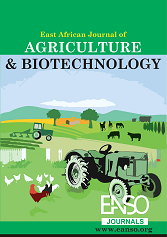Effect of Maggot Meal-Based Multi-Nutrient Blocks on Slaughter Weight and Internal Organ Characteristics of Rabbit Weaners
Abstract
House fly maggot is a potential insect that has a relatively high crude protein and mostly used in feeding monogastric animals. Twenty-four Chinchilla giganta rabbit weaners (12 males and 12 females) were used in this experiment in a randomised complete block design. Each rabbit weaner was randomly allotted to four different treatments. Each treatment was replicated three times with two rabbits per replicate. Sex was used as a blocking effect. This was done to evaluate the effects of graded levels of maggot meal-based multi-nutrient block on feed intake, daily weight gain, feed conversion ratio and internal organs weight during feeding for 56 days at Chinhoyi University of Technology farm. Feed formulation was done using I.D.T Try and Error Iteration software. Sun-dried maggot meal was used to produce four iso-nitrogenous and iso-energetic treatment multi-nutrient block diets with 0%, 5%, 10% and 15% maggot meal. An increase in the inclusion level of maggot meal had a positive effect on feed intake (P<0.05 Results from this study in rabbits revealed that although maggot meal-based diets were iso-nitrogenous (18% CP level), they differed in mean live weight gain (LWG). The study found that diets where 10-15% of housefly maggot meal was included achieved better growth rates and internal organ weights relative to soya bean meal-based diets. These maggot meal levels represent 50-80% partial replacement of soya bean meal in the diet. However, diets did not differ in heart weight. These results suggest that housefly maggot meal is a good source of protein and a suitable replacement for soya bean meal in the diets of growing rabbits post-weaning. Dietary inclusions of up to 150 g/kg (50-80% dietary replacement of soya bean meal) were recommended to ensure optimum growth performance and body composition of growing rabbits. Commercial use of this insect meal as a feed ingredient in rabbit diets would depend on industrial-scale production of the larvae and reduced costs of maggot meal
Downloads
References
Abu, O. A., Onifade, A. A., Abanikannda, O. T. F., & Obiyan, R. I. (2008, June). Status and promotional strategies for rabbit production in Nigeria. In 9th World Rabbit Congress (pp. 10-13).
Abubakar, M., Ibrahim, U., Yusuf, A. U., Muhammad, A. S. and Adamu, N. 2015. Growth performance, carcass and organ characteristics of growing rabbits fed graded levels of Moringa oleifera leaf meal in diets. Bayero Journal of Pure and Applied Sciences, 8(2): 7 – 9. http://dx.doi.org/10.4314/bajopas.v8i2.2
Assan, N. (2014). Micro-livestock farming and food security in Sub-Saharan Africa. J Anim Prod Adv, 4, 374-387.
Beinpuo, E. N. (2009). Strategic innovations in urban agriculture, food supply and livelihood support systems performance in Accra, Ghana.
Bosch, G., Veenenbos, M. E., Van Zanten, H. H. E., Meijer, N. P., van der Fels-Klerx, H. J., & van Loon, J. J. A. (2018). Efficiency of organic stream conversion by black soldier fly larvae: a review of the scientific literature. Journal of Insects as Food and Feed, 4(supplement 1), S44-S44.
Foley, J. A., Ramankutty, N., Brauman, K. A., Cassidy, E. S., Gerber, J. S., Johnston, M., ... & Balzer, C. (2011). Solutions for a cultivated planet. Nature, 478(7369), 337-342.
Frandson, Rowen D., W. Lee Wilke and Anna Dee 2009. Anatomy and physiology of farm animals, 7th Edition. Wiley-Blackwell
Huis, A. Van. (2013). The potential of Insects as Food and Feed in Assuring Food Security. https://doi.org/10.1146/annurev-ento-120811-153704
Khan, M., Chand, N., Khan, S., Khan, R.U., Sultan, A. (2018). Alternative to Soybean Meal in Broiler Ration During ABSTRACT. Brazilian Journal of Poultry Science, 9–14.
Mahmood, H. Z., Hussain, I., & Iftikhar, S. (2014). Role of Livestock in Food Security: An Ascertainment from Punjab Pakistan, 4(8), 458–470. https://doi.org/10.6007/IJARBSS/v4-i8/1121
Makinde, O. J., & Makinde, J. (2015). Maggot meal: A sustainable protein source for livestock production-A Review. Advances in Life Science and Technology. SSN, 2224-7181.
Makkar, H. P. S., Tran, G., Heuzé, V., & Ankers, P. (2014). State-of-the-art on use of insects as animal feed. Animal Feed Science and Technology, 197, 1–33.
Manyeruke, C., Hamauswa, S., & Mhandara, L. (2013). The effects of climate change and variability on food security in Zimbabwe: A socio-economic and political analysis.
Mekonnen, M. M., & Hoekstra, A. Y. (2013). The water footprint of poultry, pork and beef: A comparative study in different countries and production systems $. Water Resources and Industry, 1–2, 25–36. https://doi.org/10.1016/j.wri.2013.03.001
Meneguz, M., Dama, A., Caimi, C., Gariglio, M., Schiavone, A., Gai, F., & Gasco, L. (2018). Preliminary result of high fibre material impact on growth performance of black soldier fly larvae (Hermetia illucens). In The 2nd International Conference ‘Insects to Feed the World’(IFW 2018) (Vol. 4, No. Supplement 1)), pp. 31-31).
Molen, P. Van Der. (2016). Food security, land use and land surveyors, 6265(June), 0–6. https://doi.org/10.1080/00396265.2015.1137159
Mupepi, O., & Matsa, M. M. (2021). Spatio-temporal dynamics of drought in Zimbabwe between 1990 and 2020: a review. Spatial Information Research, 1-14.
Oonincx, D. G., Van Itterbeeck, J., Heetkamp, M. J., Van Den Brand, H., Van Loon, J. J., & Van Huis, A. (2010). An exploration on greenhouse gas and ammonia production by insect species suitable for animal or human consumption. PloS one, 5(12), e14445.
Owen, O. J., & Dike, U. A. (2013). Japanese Quail (Coturnix coturnix japonica) husbandry: a means of increasing animal protein base in developing countries. Journal of Environmental Issues and Agriculture in Developing Countries, 5(1), 1-4.
Téguia, A.; Mpoame, M.; Mba, J.A.O. 2002. The production performance of broiler birds as affected by the replacement of fish meal by maggot meal in the starter and finisher diets. Tropicultura 20, 187–192.
Wafar R. J., Yakubu B., and Lalabe B. C., 2017. Effect of feeding raw kapok (ceiba pentandra) seed meal on the growth performance, nutrient digestibility, carcass and organ weights of weaner rabbits. Asian Research Journal of Agriculture 5(3): 1-8. https://doi.org/10.9734/ARJA/2017/33431
Copyright (c) 2023 Passmore Temba Mudhanganyi, Calleb Olweny Ochia, James Madzimure

This work is licensed under a Creative Commons Attribution 4.0 International License.




























